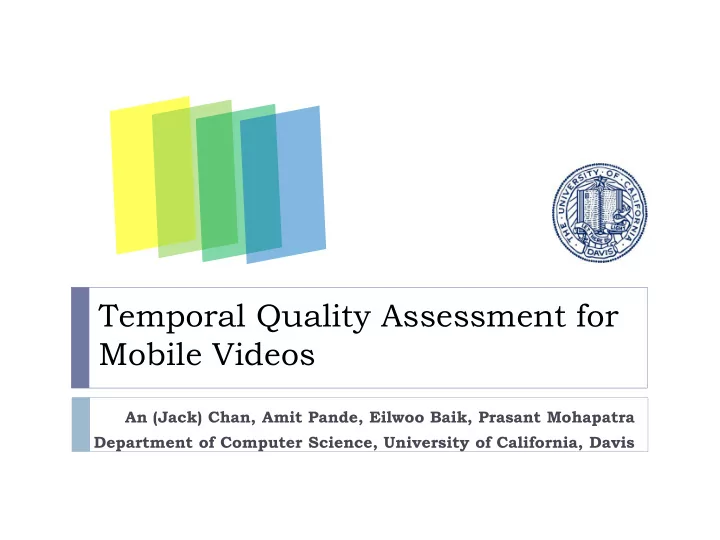

Temporal Quality Assessment for Mobile Videos An (Jack) Chan, Amit Pande, Eilwoo Baik, Prasant Mohapatra Department of Computer Science, University of California, Davis
Videos are Everywhere Cisco’s Virtual Network Index “In 2011, video traffic accounted for more than 50% in mobile networks” Evaluating mobile video quality becomes a hot topic Important for content providers and network services providers onbile.com
Assessing video quality Snap shot A Snap shot B
Assessing Video Quality • Subjective video quality metrics • Mean Opinion Score (MOS): Ranging from 1 to 5 • Evaluated by human viewers • High cost • Objective video quality metrics Evaluated by computer programs To approximate subjective measurement, MOS
Evaluation for Mobile Videos Low computational power requirement Video codec independent Network impairment estimation No original (reference) videos greenwala.com Correlated to subjective scores storage-news.com sciencedirect.com
Outline Objective Video Quality Temporal Variation Metric (TVM) Measure temporal information at low cost Temporal Variation Index (TVI) Reduced-reference video quality metric Estimates subjective video quality Estimates network impairments
Spatial and Temporal Quality Spatial quality assessment Blocking and blurring Image quality measurement Pixel-by-pixel comparison (e.g. PSNR, SSIM) Temporal quality assessment Jerkiness and freezing sciencedirect.com Optical flows More pervasive in wireless mobile networks
Related Work Partially evaluated [Vidal2006][Yang2007] Focus on the effect from network packet loss No high correlation to subjective scores Modeling human visual system e.g. MOVIE [Sesha2010] Evaluate both spatial and temporal quality High complexity Require original copies Motion Vector Reuse [Moorthy2010] Codec-dependent
Measuring Temporal Information Temporal Variation Metric (TVM) Difference between two neighboring frames Difference Frame p Frame p -1 Other consecutive frame comparison techniques Temporal versions of SSIM, ESS VSNR TSSIM, TESS and TVSNR
Searching for the Best Candidate Test with video clips Length from 10 to 60 seconds Resolution from 352X288 to 1920X1080 Motion degree from slow to very fast
TVM Outperforms the Others
Temporal Variation Index (TVI) An Reduced-Reference T emporal Quality Metric TVM of the TVM of the original video received video From out-of- Calculated locally band control channel, e.g. TVI RTCP sender report
Subjective Experiments Derivation Developed an Android app Engaged 17 volunteers Collected 50 video clips (3 motion groups) Measured Mean Opinion Score (MOS) Calculate TVM and TVI adroid.com
Estimating Quality of Experience Strong linear correlation Slow motion Moderate motion Pearson correlation coefficient ranges from 0.87 to 0.96 Fast motion
Network Experiments Set up an 802.11n single-hop testbed Streaming videos (3 motion groups) Introduce packet loss and delay Calculate TVM and TVI Collect 183 video samples
Detecting Packet Loss Causes blocking, blurring and freezing TVM in received video is inconsistent with that in the original video Freezing leads to infinite TVM
Detecting Packet Loss Causes blocking, blurring and freezing TVM in received video is inconsistent with that in the original video Freezing leads to infinite TVM
Estimating Packet Loss Rate Strong linear correlation Slow motion Moderate motion Evaluated with 45 videos Pearson correlation coefficient ranges from 0.90 to 0.96 Fast motion
Detecting End-to-End Delay Results in freezing Infinite TVM values TVM of the received video is like a delayed version of that of the original video
Estimating End-to-End Delay delay happens Evaluated by randomly chosen videos The average accuracy rate ~ 95%
Conclusions TVM to measure the temporal information at low cost Derive TVI as a quality and network condition predictor TVI is highly correlated with MOS (0.925) TVI is highly correlated with packet loss rate (0.94) Predict end-to-end delay with 95% accuracy
References [Vidal2006] R. Pastrana-Vidal and J. Gicquel. Automatic quality assessment of video fluidity impairments using a no-reference metric. In Proc. of Int. Workshop on Video Processing and Quality Metrics for Consumer Electronics , 2006. [Yang2007] K.-C. Yang, C. Guest, K. El-Maleh, and P. Das. Perceptual temporal quality metric for compressed video. Multimedia, IEEE Transactions on , 9(7):1528 – 1535, nov. 2007. [Sesha2010] K. Seshadrinathan and A. C. Bovik. Motion tuned spatio- temporal quality assessment of natural videos. IEEE Trans. on Image Processing. , 2010. [Moorthy2010] A. K. Moorthy and A. C. Bovik. Efficient video quality assessment along temporal trajectories. IEEE Trans. Circuits Syst. Video Techn ., 20(11):1653 – 1658, 2010.
Thank you Questions and Answers
Recommend
More recommend